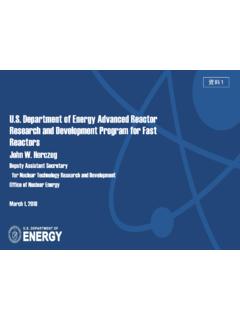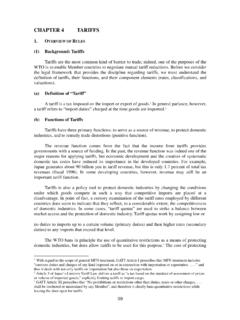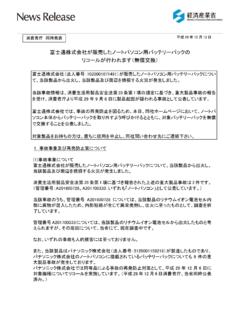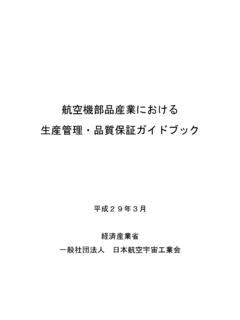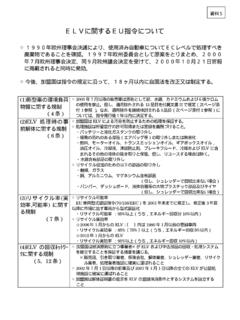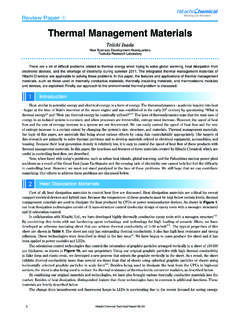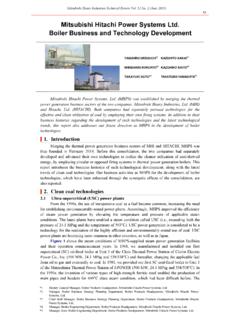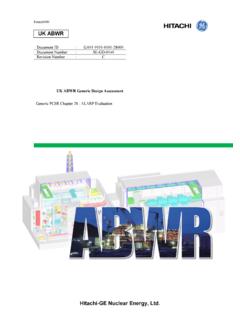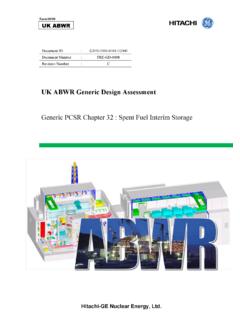Transcription of The Feasibility Study Report On Lagos Thermal …
1 The Feasibility Study Report On Lagos Thermal power Plant expansion project in federal republic of Nigeria March 2016. Ministry of Economy, Trade and Industry Japan Marubeni Corporation Contents Chapter 1 Purpose of the Survey i Chapter 2 Electricity Supply and Demand i Chapter 3 Selection of the project Site ii Chapter 4 Materialization of the project Plan iii power generation method selection iii Composition of the power plant and specifications iv Capacity of the new power plant v Generated electricity delivery facilities vi project implementation schedule vi project cost estimation vii Chapter 5 Economic and Financial Analysis viii Economic and financial analysis viii Fund raising and repayment plan viii Chapter 6 Environmental and Social Considerations ix Environmental
2 Impact Assessment (EIA) according to laws and regulations in Nigeria ix Underlying principles of environmental considerations in the JBIC. Guidelines x Chapter 7 Economic and Social Impact of project Implementation xiii Attachment Drawings xv Chapter 1 Purpose of the Survey The federal republic of Nigeria (hereinafter referred to as Nigeria ) has the largest population in Africa, with approximately 182 million people. According to the latest economic statistics, Nigeria overtook South Africa to become Africa's largest economy. The Nigerian economy has been steadily growing, with the largest oil production and natural gas reserves in Africa, as well as strong growth in non-oil sectors.
3 As for the power sector, however, because power supply facilities have not been properly maintained, upgraded or newly constructed in the past, the supply capacity is overwhelmingly insufficient for the potential demand, causing frequent planned outages and accidental outages in the entire power system. In such circumstances, the Government of Nigeria has promoted the National Integrated power project (NIPP) and privatization of the power sector. However, in order to respond to the present potential electricity demand and the electricity demand that is likely to increase sharply in the future, an expansion of electricity facilities and streamlining of the existing gas turbine and Thermal power generating systems are urgently needed.
4 As a part of the expansion of electricity facilities, efficiency must be improved through construction of a gas-fired Thermal power plant and a large, high-efficiency gas combined cycle power plant. This project will carry out a basic survey on the present state of the existing power supply facilities and plans to expand the electricity facilities. It will also carry out a Feasibility survey with an eye to formulating a plan to introduce a high-efficiency gas combined cycle power plant that utilizes Japan's technology to the maximum extent and to receive a construction order for such a plant. Chapter 2 Electricity Supply and Demand In Nigeria, the potential electricity demand considerably outstrips the supply capacity, and planned outages are conducted on a routine basis.
5 Therefore, factories, commercial facilities and general households use non-utility generation facilities to prepare for outages and make up for daily power shortages. The maximum power output grew at an annual average of in 2009-2016, but the output was a mere 5,075MW in 2016, which is about one third of the peak demand of 14,630MW. The power consumption per person in Nigeria is extremely low compared to countries of the same level of GDP per capita: for example, it is roughly one tenth of that in Vietnam. It is even lower than that of countries with lower levels of GDP. per capita, such as Ghana and Mozambique. The Energy Commission of Nigeria (ECN) forecasts that the electricity demand (on the basis of generated electric energy) will continue growing at an annual rate of until 2050.
6 Therefore, electricity supply facilities must be strengthened urgently to respond to the present shortage and future growth in demand. The country has a total of 25 power plants , consisting of three hydropower and 22 Thermal power plants . The rated capacity is a total of 11,675MW. However, due to trouble, maintenance of the facilities and other i reasons, the available capacity is 7,140MW, or just 61% of the rated capacity. Moreover, the power output is restricted by restrictions on the transmission capacity and gas supply, and therefore the actual capacity is only about 3,000-4,000MW. Chapter 3 Selection of the project Site The project site must satisfy necessary requirements and will be selected from four power plants , that is: (i) Egbin Thermal power Plant, a conventional dual fired system (gas and heavy oil) to which Marubeni Corporation delivered power plants made by Mitsubishi Hitachi power Systems, Ltd.
7 (MHPS, former Hitachi, Ltd.); (ii) Calabar power Plant, a simple cycle gas turbine plant; (iii) Sapele power Plant, a simple cycle gas turbine power plant; and (iv) Ihovbor power Plant, a simple cycle gas turbine power plant. The requirements that the project site must meet have been set forth as follows with the assumption of constructing a gas turbine combined cycle power plant that has a rated output of 1,300-1,900MW. (i) A construction site with an area of 20ha or more is available. (ii) Water is available for use as boiler supply water. (iii) The natural gas supply pressure is sufficient, or higher, and 300 MMCFD or more can be secured. (iv) The site is connected to a 330kV transmission line, and is able to connect to additional lines.
8 (v) The site is near an area where electricity is in demand. (vi) The site is far from any densely-populated area. (vii) The site is free from any restrictions on the transport of heavy and large cargo. The seven items above have been evaluated for the four candidate sites as shown in Table , and it has been concluded that it will be the most appropriate measure to construct a gas turbine combined cycle power plant on a site adjacent to the Egbin Thermal power Plant. Table Evaluations of Candidate project Sites Item Egbin Calabar Sapele Ihovbor 1 A construction site with A site with an area Impossible on theImpossible on theImpossible on the an area of 20ha or more of 20ha or more can present site.
9 Sitepresent site. Sitepresent site. Site is available. be secured. expansion is needed. expansion is needed. expansion is needed.. 2 Water is available for . use as boiler supply water. 3 The natural gas supply . pressure is sufficient, (Addition al (No gas supply). or higher, and pipeline must be 300 MMCFD or more laid down.). can be secured. 4 The site is connected to 6 330kV lines 4 330kV lines 6330kV lines 4 330kV lines a 330kV transmission . line, and is able to (The facilities are connect to additional aged). lines. ii Item Egbin Calabar Sapele Ihovbor 5 The site is near an area Lagos Calabar Bennin Bennin where electricity is in . demand.
10 6 The site is far from any . densely-populated area. 7 The site is free from About 350t of cargo About 230t of cargo About 230t of cargo About 230t of cargo any restrictions on the was transported for was transported for was transported for was transported for transport of heavy and construction of the construction of the construction of the construction of the large cargo. present plant. present plant. present plant. present plant.. Overall evaluation . Chapter 4 Materialization of the project Plan power generation method selection Four power generation methods may be applicable to the plant to be built under this project : that is, (1) a simple cycle gas turbine plant with a high efficiency large gas turbine; (2) a high efficiency gas combined cycle power plant with a large gas turbine; (3) a supercritical pressure conventional steam turbine power plant; and (4) a large gas engine power plant.
